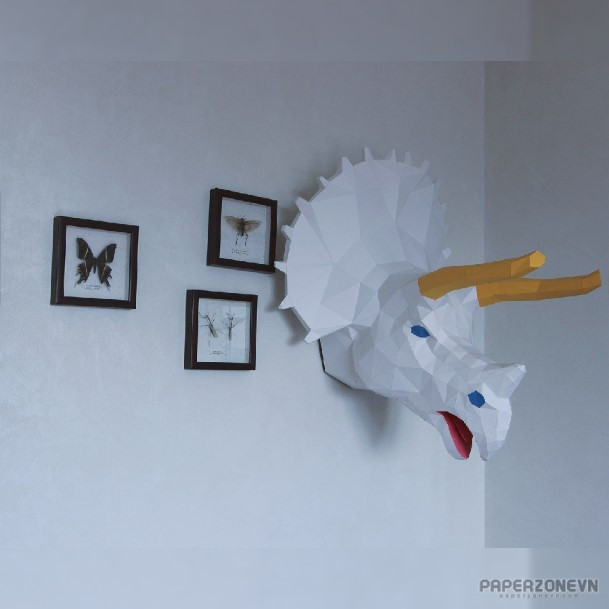- Thumbnail
-

- Resources
- Nhận được từ mạng
- Author
- Unknown (không rõ)
- Printed File Format
- PDO
- Page(s)
- 50
- Part(s)
- 163
- Instruction Format
- PDO
Wall hanging - Triceratops Head Papercraft
In the first attempt to understand the many species, Richard Swann Lull found two groups, although he did not say how he distinguished them: One composed of T. horridus, T. prorsus, and T. brevicornus ('the short-horned'); the other of T. elatus and T. calicornis. Two species (T. serratus and T. flabellatus) stood apart from these groups. By 1933 and his revision of the landmark 1907 Hatcher–Marsh–Lull monograph of all known ceratopsians, he retained his two groups and two unaffiliated species, with a third lineage of T. obtusus and T. hatcheri ('Hatcher's') that was characterized by a very small nasal horn. T. horridus–T. prorsus–T. brevicornus was now thought to be the most conservative lineage, with an increase in skull size and a decrease in nasal horn size, and T. elatus–T. calicornis was defined by large brow horns and small nasal horn.[9][16] C. M. Sternberg made one modification, adding T. eurycephalus ('the wide-headed') and suggesting that it linked the second and third lineages closer together than they were to the T. horridus lineage.


In the first attempt to understand the many species, Richard Swann Lull found two groups, although he did not say how he distinguished them: One composed of T. horridus, T. prorsus, and T. brevicornus ('the short-horned'); the other of T. elatus and T. calicornis. Two species (T. serratus and T. flabellatus) stood apart from these groups. By 1933 and his revision of the landmark 1907 Hatcher–Marsh–Lull monograph of all known ceratopsians, he retained his two groups and two unaffiliated species, with a third lineage of T. obtusus and T. hatcheri ('Hatcher's') that was characterized by a very small nasal horn. T. horridus–T. prorsus–T. brevicornus was now thought to be the most conservative lineage, with an increase in skull size and a decrease in nasal horn size, and T. elatus–T. calicornis was defined by large brow horns and small nasal horn.[9][16] C. M. Sternberg made one modification, adding T. eurycephalus ('the wide-headed') and suggesting that it linked the second and third lineages closer together than they were to the T. horridus lineage.


Sponsored: Google Advertising
Attachments
Last edited by a moderator:
